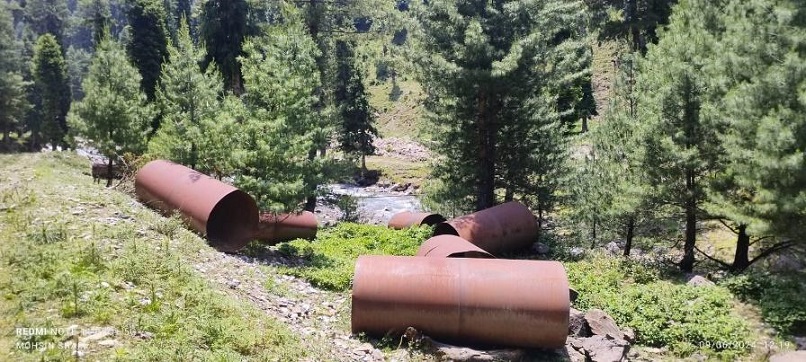
By Peerzada Mohsin Shafi
Water, a divine gift is essential to all living beings. It plays a crucial role in daily life and industries alike. Since the industrial revolution, humanity has recognized the immense power of water and devised methods to harness its benefits.
According to the 2022 report by the United Nations Industrial Development Organization (UNIDO) on the International Centre for Small Hydro Projects, over 60 percent of the global small hydropower potential remains untapped. Across the globe, there are vast opportunities to utilize Small Hydropower Projects (SHP) for the benefit of local communities and the planet.
Decentralized systems like SHP can significantly contribute to sustainable energy goals. SHP provides a steady baseload of energy, facilitating positive changes in the communities where these plants are constructed, as well as beyond. In regions with low levels of electricity access, SHP plants offer immediate welfare improvements and knock-on benefits such as job creation, income generation, and enhanced delivery of critical social services, including education and healthcare.
India has launched several initiatives to develop SHP projects, recognizing their potential for clean, renewable energy. Key measures include the National Policy for Small Hydropower Development (1999) and the Hydro Power Policy (2008), which promote SHP projects up to 25 MW with simplified clearances and financial incentives.
The Ministry of New and Renewable Energy (MNRE) offers subsidies and Central Financial Assistance (CFA) to support the capital costs of SHP projects. Additionally, the government promotes Public-Private Partnerships (PPP) and streamlines clearance processes to attract private investment and expedite project implementation.
These initiatives aim to boost India’s renewable energy capacity and rural electrification efforts. Despite abundant water resources, the Government of Jammu & Kashmir (J&K) has harnessed only about 15 percent of its potential, primarily through medium and large hydroelectric projects. The total identified potential of small hydel projects (up to 25 MW) in J&K is approximately 1500 MW, indicating significant room for development.
The Jammu and Kashmir Energy Development Agency (JAKEDA) is the implementing agency for SHP in the region, guided by the Policy for Development of Small Hydro Energy for Power Generation, 2016 (up to 10 MW). While hydel policies of 2003 and 2011 offered various incentives to developers, there is ample scope for policy improvement to make it more investor-friendly.
Recently, the Government of J&K enhanced JAKEDA’s mandate from 2 MW to 10 MW. The objective was to create an investor-friendly environment to achieve a 1000 MW installed capacity target within the next 10 years, divided equally between Engineering, Procurement, and Construction (EPC) mode and Independent Power Producers (IPP) mode.
This initiative aimed to propel JAKEDA into a 5000-crore company over the next decade, with IPPs allowed to produce independent power for sale. No new data is available on JAKEDA’s website after January 2022. As of then, only 4 out of 25 IPPs had been commissioned. In Anantnag district, the Ichoo MHP of 5 MW has been commissioned, but the Dedibal SHP of 1.65 MW lags with only 10 percent of civil works completed. Similarly, in Budgam, the Dudhpathri MHP of 6 MW has only 5 percent of civil work completed. Other projects face similar issues, ranging from land disputes to pending departmental compliances.
The Jammu & Kashmir Government introduced a new hydropower project policy in 2022, reiterating the goals of previous policies but with little concrete progress on the ground. The government must develop solid, innovative policies rather than replicating existing ones, such as the draft policy of Solar Energy of Uttarakhand, to fully harness the benefits of hydropower.
In conclusion, while small hydropower projects have tremendous potential to transform local communities and contribute to sustainable energy goals, significant challenges remain. It is imperative for the government to address these issues with effective, original policies to unlock the true potential of hydro power in the Valley of Kashmir.
Views expressed in the article are the author’s own and do not necessarily represent the editorial stance of Kashmir Observer
- The author is a Researcher, Planning and Contracts Engineer
Follow this link to join our WhatsApp group: Join Now
Be Part of Quality Journalism |
Quality journalism takes a lot of time, money and hard work to produce and despite all the hardships we still do it. Our reporters and editors are working overtime in Kashmir and beyond to cover what you care about, break big stories, and expose injustices that can change lives. Today more people are reading Kashmir Observer than ever, but only a handful are paying while advertising revenues are falling fast. |
| ACT NOW |
| MONTHLY | Rs 100 | |
| YEARLY | Rs 1000 | |
| LIFETIME | Rs 10000 | |











